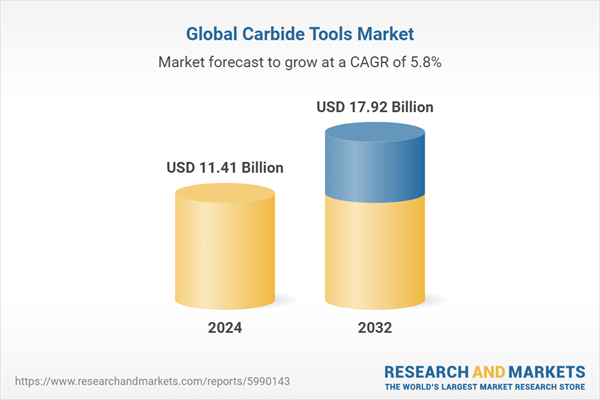Carbide tools are cutting tools used predominantly in industrial and mechanical processes to machine and shape a variety of materials like metals, plastics, and wood. Made primarily from tungsten carbide, a compound of tungsten and carbon, these tools are prized for their hardness, resistance to wear and tear, and ability to retain a sharp cutting edge at high temperatures. Common carbide tools include drills, end mills, inserts, and rotary burrs, each essential for detailed and high-strength cutting tasks.
Innovation in coatings has become a significant trend increasing the carbide tools market value. Multi-layer coatings such as Titanium Aluminum Nitride (TiAlN) or Diamond-like Carbon (DLC) are being applied to enhance the hardness, heat resistance, and durability of these tools. These coatings extend the life of carbide tools and enable their use in high-speed applications and in cutting harder materials, thus broadening their applicability across more demanding industrial tasks. The development of nanocomposite coatings represents another breakthrough, offering even greater resistance to wear and thermal stress.
As per the carbide tools market analysis, there is a growing demand for customised carbide tools that cater to specific market needs. Manufacturers are increasingly offering bespoke solutions designed to optimise performance for unique materials or complex machining operations. This trend is particularly prominent in industries such as aerospace and automotive manufacturing, where precision and efficiency are paramount. Customisation also extends to providing tools that can integrate seamlessly with automated systems and advanced manufacturing setups, enhancing overall productivity and reducing downtime.
As per the carbide tools market outlook, carbide tools are becoming smarter with the integration of sensors and connectivity technologies that align with Industry 4.0 principles. These tools can now be equipped with sensors that monitor performance, predict wear and tear, and even suggest optimal replacement times. This connectivity allows for real-time data analysis and better inventory management, leading to more predictive maintenance schedules and reduced machine downtime. The use of IoT technology also facilitates the remote monitoring and control of tool operations, enhancing flexibility and responsiveness in manufacturing processes.
Environmental sustainability is driving changes in the manufacturing processes of carbide tools. There is an increasing focus on recycling carbide materials and reducing the environmental footprint associated with raw material extraction, which contributes to the carbide tools market development. Additionally, manufacturers are exploring the use of renewable energy sources in production processes and striving to minimise waste through lean manufacturing techniques. This not only helps companies adhere to stringent environmental regulations but also appeals to environmentally conscious consumers.
Carbide tools are finding new applications in specialised fields such as micro-machining and medical device manufacturing, which aids the carbide tools market growth. In micro-machining, tools with very small diameters are required to produce intricate parts with high precision. The medical sector relies on carbide tools for manufacturing implants and surgical instruments. As these specialised applications often require exceptional precision and reliability, the demand for high-quality carbide tools is expected to increase significantly.
Recent advancements focus not just on the material and coating of tools but also on optimising their geometry. The design and geometry of carbide tools are crucial in determining their cutting efficiency and lifespan. Innovative designs that reduce vibration and improve chip evacuation are becoming more prevalent and aiding the carbide tools market expansion. These geometrical enhancements are tailored to specific machining processes or materials, further improving the performance and range of applications for carbide tools.
Market Segmentation
The market can be divided based on product type, coating type, configuration, end use, and region.Market Breakup by Product Type
- Drilling Tools
- Milling Tools
- Turning Tools
- Others
Market Breakup by Coating Type
- Coated
- Non-coated
Market Breakup by Configuration
- Hand-based
- Machine-based
Market Breakup by End Use
- Automotive
- Construction
- Metal Fabrication
- Electronics and Electrical
- Aerospace
- Others
Market Breakup by Region
- North America
- Europe
- Asia Pacific
- Latin America
- Middle East and Africa
Competitive Landscape
The report looks into the market shares, plant turnarounds, capacities, investments, and mergers and acquisitions, among other major developments, of the leading companies operating in the global carbide tools market. Some of the major players explored in the report are as follows:- OSG Corporation
- Sandvik AB
- Kennametal Inc
- Sumitomo Electric Industries, Limited
- Guhring, Inc
- Fullerton Tool Company, Inc
- Ingersoll Cutting Tool Company
- KYOCERA SGS Precision Tools
- Elenco Carbide Tool Corp.
- Others
Table of Contents
Companies Mentioned
- OSG Corporation
- Sandvik AB
- Kennametal Inc
- Sumitomo Electric Industries Limited
- Guhring Inc
- Fullerton Tool Company Inc
- Ingersoll Cutting Tool Company
- KYOCERA SGS Precision Tools
- Elenco Carbide Tool Corp.
Methodology

LOADING...
Table Information
| Report Attribute | Details |
|---|---|
| No. of Pages | 164 |
| Published | July 2024 |
| Forecast Period | 2024 - 2032 |
| Estimated Market Value ( USD | $ 11.41 Billion |
| Forecasted Market Value ( USD | $ 17.92 Billion |
| Compound Annual Growth Rate | 5.8% |
| Regions Covered | Global |
| No. of Companies Mentioned | 9 |








